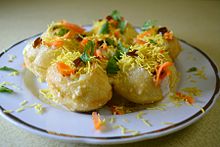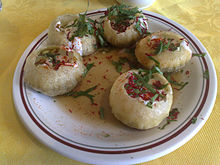food.wikisort.org - Dish
Chaat, or chāt (IAST: cāṭ) (lit. 'lick, tasting, delicacy') is a family of savoury snacks that originated in India, typically served as an hors d'oeuvre or at roadside tracks from stalls or food carts across South Asia in India, Pakistan, Nepal and Bangladesh.[1][2] With its origins in Uttar Pradesh, India,[3] chaat has become immensely popular in the rest of South Asia.
This article needs additional citations for verification. (March 2013) |
 | |
| Alternative names | Saat (Sylhet) |
|---|---|
| Type | Snack |
| Place of origin | India |
| Region or state | Odisha, West Bengal, Uttar Pradesh and Madhya Pradesh |
Etymology

The word derives from Hindi cāṭ चाट (tasting, a delicacy), from cāṭnā चाटना (to lick, as in licking one's fingers while eating), from Prakrit caṭṭei चट्टेइ (to devour with relish, eat noisily).[4]
Overview


The chaat variants are all based on fried dough, with various other ingredients. The original chaat is a mixture of potato pieces, crisp fried bread dahi vada or dahi bhalla, gram or chickpeas and tangy-salty spices, with sour Indian chili and saunth (dried ginger and tamarind sauce), fresh green coriander leaves and yogurt for garnish, but other popular variants included alu tikkis or samosa (garnished with onion, potatoes, coriander, peas, hot spices and a dash of yogurt), bhel puri, dahi puri, panipuri, dahi vada, papri chaat, and sev puri.
There are common elements among these variants including dahi (yogurt); chopped onions and coriander; sev (thin dried yellow salty noodles); and chaat masala, typically consisting of amchoor (dried mango powder), cumin, kala namak (Himalayan black rock salt), coriander, dried ginger, salt, black pepper, and red pepper. The ingredients are combined and served on a small metal plate or a banana leaf, dried and formed into a bowl.
History
Some of the dishes now categorized as chaats, such as Dahi Vada, can be traced back to ancient periods. A recipe for a dahi vada analogue called kshiravata is mentioned in Manasollasa, a 12th-century Sanskrit encyclopedia compiled by Someshvara III, who ruled from present-day Karnataka.[5][6] According to food historian K.T Achaya, descriptions of dahi vada also appear in literature far ealier from 500 BC.[7]
Chaat as an organized phenomenon or distinct group of dishes, according to culinary anthropologist Kurush Dalal, originated in northern India (now Uttar Pradesh) in the late 17th century during the reign of Mughal Emperor Shah Jahan. The royal doctors had asked the people of Delhi to consume spicy and fried snacks, as well as dahi, as a countermeasure to the alkaline water of the Yamuna river that coursed through the city. Thus, chaat was invented.[8]
Most chaats originated in some parts of Uttar Pradesh in India,[9] but they are now eaten all across South Asia and neighboring countries. Some are results of cultural syncretism.
Regions
Chaat is famous in South Asia in India, Pakistan, Nepal and Bangladesh.
Variations





- Alu chaat - Potatoes (alu in Hindi) cut into small pieces, fried till crisp and served with chutney
- Alu tikki
- Bedmi - Puri stuffed with dal and fried till crisp. Typically served with alu sabji and eaten for breakfast
- Bhalla/alu tikki
- Bhelpuri
- Ragda patties (alu tikki chaat)
- Cheela- Besan (chickpea flour) pancakes served with chutney and sooth (sweet chutney)
- Chotpoti, mixture of boiled diced potatoes, boiled chickpeas and sliced onions and chillies with grated eggs on top. Many kinds of roasted spice powder are used in its preparation.
- Dahi puri
- Dahi vada
- Kachori- or Kachauri, with variants such as Khasta Kachuari
- Mangode - Similar to pakora, but besan paste is replaced with yellow moong paste
- Pakora - Different things such as paneer, vegetable dipped in besan (chickpea/gram flour) paste and fried.
- Panipuri
- Masalapuri
- Chana chaat
- Papri chaat - This contains fried patty called papri as an extra ingredient.
- Samosa chaat - samosa is broken into pieces with green and sweet chutney added to it.
- Sevpuri
- Vada pav
- Dahi bhallay ki chaat (bhallay, potatoes, chickpeas, imli chutney, chaat masala, onions, tomatoes, dahi etc.)
- Beetroot & potato chaat[10]
- Dhaka chaat[11]
- Paneer chaat puri
- Thattu Vadai Set[12]
- Dal ki chaat - Made with moong dal mixed with spices and chutney and accompanied with wheat biscuits. Popular in Meerut
- Raj kachori - a big hollow ball made with wheat and filled with sprouts, chickpeas, potatoes, bhalla and chutneys (sweet and green).
- Basket chaat - Edible bowl made with potato and filled with sprouts, chickpeas, potato and chutneys . Popular in Lucknow
- Daulat ki chaat - A sweet preparation made from keeping condensed milk in winter mist.
- Ram ladoo - Round fitters made from mong dal and served with radish and grey chutney.
- Dabeli - a sweet and sour burger like Gujrati snack made with potatoes, sev , groundnut and pomegranate
- Barule - whole potato coated with besan is deepfried and served with green chutney.[13]
See also
- List of Indian snack foods
- List of tapas (Spanish snacks)
 Food portal
Food portal
References
- Thumma, Sanjay. "Chaat Recipes". Hyderabad, India: Vahrehvah.com. Archived from the original on 3 November 2012. Retrieved 27 November 2012.
- "The Chaat Business". infokosh.bangladesh.gov.bd (in Bengali). Archived from the original on 29 November 2012. Retrieved 17 October 2012.
- "10 Best Recipes From Uttar Pradesh (Varanasi/ Agra / Mathura )". NDTV. 25 October 2013. Archived from the original on 28 October 2013. Retrieved 26 October 2013.
- Oxford English Dictionary. Chaat. Mar. 2005 Online edition. Retrieved 18 February 2008.
- K.T. Achaya (2003). The Story of Our Food. Universities Press. p. 85. ISBN 978-81-7371-293-7.
- Vishal, Anoothi. "Chaat Masala: Gourmet Indian street food". The Economic Times. Retrieved 4 September 2020.
- Krishna, Priya (17 August 2020). "Chaat Is More Than the Sum of Its Many Flavors". The New York Times. ISSN 0362-4331. Retrieved 4 September 2020.
- Ramadurai, Charukesi (3 June 2020). "Pani Puri: India's favourite street food... at home?". BBC Travel. Retrieved 25 August 2020.
- "10 Best Recipes From Uttar Pradesh (Varanasi/ Agra / Mathura )". NDTV. 25 October 2013. Archived from the original on 28 October 2013. Retrieved 26 October 2013.
- Moghul, Sobiya N. (25 October 2013). "Beetroot and potato chaat recipe". The Times of India. Archived from the original on 15 November 2013. Retrieved 15 November 2013.
- D.Nath, Subha. "Dhaka chaat" (PDF). Archived from the original (PDF) on 9 November 2017. Retrieved 9 November 2017.
- Saravanan, S.P. (28 October 2015). "Salem's own evening Snack". The Hindu. Retrieved 22 January 2018.
- "Watch: Viral Video of a Famous Street Food Disapproved by the Internet; Here's Why".
External links
 Media related to Chaat at Wikimedia Commons
Media related to Chaat at Wikimedia Commons
Другой контент может иметь иную лицензию. Перед использованием материалов сайта WikiSort.org внимательно изучите правила лицензирования конкретных элементов наполнения сайта.
WikiSort.org - проект по пересортировке и дополнению контента Википедии



